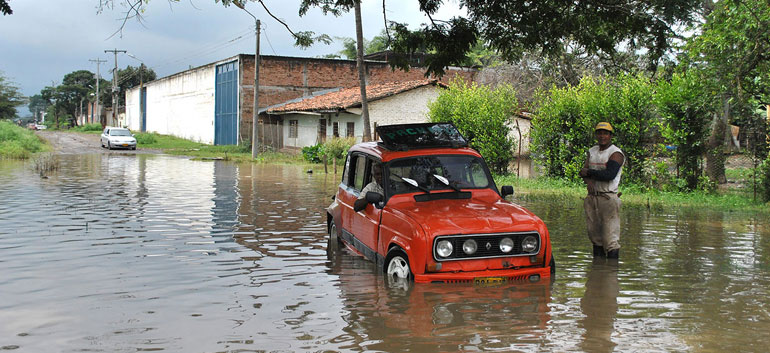Twenty-three states in Colombia have been placed on orange or red alert, as torrential downpours marking the start of the regional rainy season hit communities throughout the country.
According to the national agency for disaster management, some 7,267 families in 174 municipalities have been affected by heavy rains since March. The resulting floods and landslides have been most heavily concentrated in Colombia’s Pacific, Amazon, and Andean regions, and have caused at least seven deaths during the same timeframe.
Since March alone, there have been 286 severe weather events registered throughout the country, according to RCN Radio.
In one of the more prominent cases, the capital of the southwestern state of Caqueta flooded last week, damaging the property of 450 families in 15 neighborhoods, according to the agency for disaster management. In other areas, the effects were likely aggravated by a protracted drought that preceded the start of the rainy season and left the soil dry and loose.
MORE: Meteorologists warn of ‘El Niño’ weather phenomenon in 2014
Colombia’s institute of hydrology, meteorology, and environmental studies has declared that the probability of the weather phenomena “El Niño” striking the country in July, August, and September of this year is 68% and that the climax of El Niño will occur with 79% probability in the months of October, November, and December.
El Niño is a weather phenomena caused by rising sea surface temperatures off Colombia’s Pacific coast. In Colombia, the effects are massive floods, causing severe flooding in some areas — as was the case in early 2011 — and droughts in others.
MORE: Drought in northern Colombia at crisis levels
The director for the national agency for disaster management, Carlos Ivan Marquez, said his agency is working with regional governors to address the emergency in the southern state of Putumayo and to develop contingency plans for the state of Caqueta. The agency advises citizens to beware of high risk areas for flooding and landslides and to begin collecting the most rainwater possible, considering that the region is approaching the dry season of El Niño.
Last December, the agency made similar warnings ahead of the three-month drought that devastated the north, east, and northeast of the country. Local authorities largely failed to take the appropriate precautionary measures, however, a factor that contributed to the ensuing damage.
The agency for disaster management has approved financial assistance for three departments. Atlantico, Choco, and Magdalena will be receiving close to $370,000 in the form of food and kitchen material, building material, and night kits. Other similar emergency measures are currently being considered.
Colombia as a whole stands relatively ill-prepared to face extreme weather events, with its limited national infrastructure encumbering emergency response and a lack of institutional resources devoted to precautionary environmental measures. A 2007 World Bank report estimated that the country spends almost 4% of its annual GDP because of poor environmental planning.
Sources
- Aumenta notablemente la probabilidad de inicio de un fenomeno ‘El Nino’ a mediados de 2014 (IDEAM)
- Monitoreo de emergencias en el país tras las lluvias registradas en el territorio nacional (Gestion del Riesgo)
- El país permanece en alerta por temporada de lluvias (RCN Radio)
- Lluvias dejan siete muertos y 23 departamentos en alerta naranja (Vanguardia)



